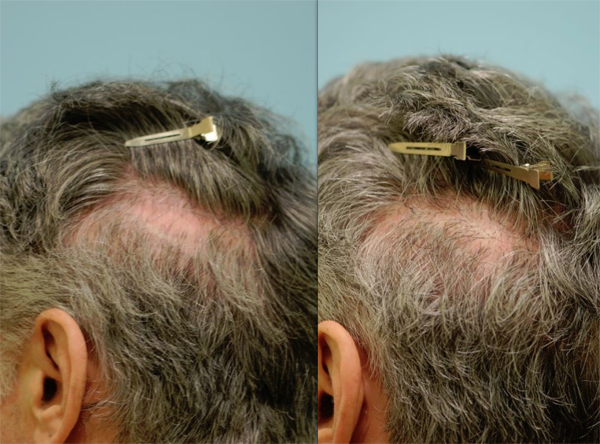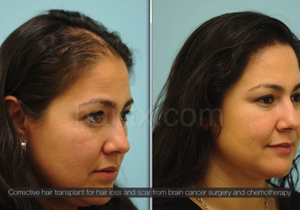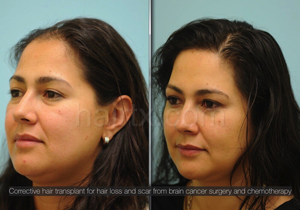Scar Repair
Scar revision is a specialty of Dr. Lam’s. The two most common solutions are advanced surgical scar revision techniques like a so-called geometric broken line repairand a hair-transplant technique to implant hairs into a scar.Although the geometric broken line technique is a successful method of scar repair in hands of a skillful plastic surgeon, not every patient is a candidate for this procedure. Sometimes, excising an old scar may cause another sometimes even wider scar. Consequently, in specific situations transplanting hairs into a scar may be the best solution to scar repair. A common reason for hair transplant would be the loss of the sideburn, temple, and behind the ear in traditional facelift surgery that robs a woman (and man) of these vital hairs that contribute to both naturalness and youth. Another reason would be due to prior scalp surgeries like skin cancer surgeries of the scalp or browlifting or brain surgery that lead to scalp hair loss. Hair loss from scars can occur anywhere there is hair, like in the eyebrows, beard, chest, pubis, etc. Of course, hair loss can occur in the back of the head from prior hair-transplant surgery.
Contact Us Today! Read Our Manifesto Visit Our Gallery
Virtual Consults

This gentleman had natural thinning of his right eyebrow as well as significant hair loss in his left eyebrow due to prior basal cell cancer that was reconstructed with a forehead skin flap. He had a failed prior eyebrow hair transplant done elsewhere with poor growth and misangled grafts that required punch removal of prior grafts before undertaking a revision procedure. He is shown before and nine months after a single eyebrow hair transplant procedure to reconstruct both eyebrows.
There are various methods of harvesting hairs in order to undertake scar repair, such as FU-strip, FUE or body hair transplant. In addition, medical tattooingis a non-surgical technique that can help camouflage scars and make them blend better with surrounding hairs. Considering that there are many ways to repair scars, during the consultation, Dr. Lam will discuss with you the method or combination of methods that would best suit your specific situation.For example, with a prior hair transplant scar in the back of the head, if the person is prone to scarring in this area, then an FUE method may be ideal to avoid further scarring. If there is no more hair left, then hair maybe taken from the beard area. Scalp micropigmentation (SMP) can be combined with any method to further improve the result. For facelift scars, oftentimes the traditional FU-strip method may be preferred for the following reasons: 1) could be combined with a larger concurrent hair transplant 2) provides better quality grafts 3) avoids the need for any preparatory scalp shaving. If the scar is contracted, thickened, or misaligned, a formal scar revision involving the excision of skin and repair may be an important initial step before hair transplant into the scar can be undertaken. Dr. Lam is skilled at both the surgical scar revision as well as the subsequent hair transplant. However, it is worth stating here that scalp hair loss typically is not very amenable to excisional methods of repair, i.e., cutting out the scar and closing it oftentimes leads to the same recurrence of the previous scar. Scalp scars are truly unique entities and cannot be compared with facial scars. Usually, the prior scar arose from either poor surgical technique or the anatomical predisposition of the patient to form scars.

This patient had a large scar on her scalp from prior skin cancer removal and underwent a hair transplant using the strip method to repair the damage and is shown after a single procedure.
Either way, the blood supply to the area is already typically compromised to the point that simply excising the scar will cause a recurrence. Interestingly, more elaborate scar repair techniques used on the face are ill advised in the scalp because they actually cause the scar to worsen. Dr. Lam has observed many patients who have sought a facial plastic surgeon or plastic surgeon to repair a scalp scar only to find that the scar either did not change or instead worsened. Accordingly, hair transplant into the scar and/or SMP are the preferred methods of treatment.

This patient had a linear donor scar from multiple previous hair transplants which was repaired using FUE hair transplant into the scar.
When transplanting into scars, Dr. Lam employs a specialized method for transplantation using micropunchingto attain a better outcome. These tiny punches remove a small core of the scar with each punch so as to achieve the following objectives:
- physical reduction of the bald scar
- replacement of unhealthy scar tissue with healthy hair graft tissue
- better access and contact with the underlying healthy blood supply to improve graft growth
- physical relaxation of the scar tissue.
Dr. Lam also believes that the use of bioenhancement technology like PRP, ACell, and liposomal ATP are critical in scar repairs to enhance graft survival in areas of otherwise diminished blood supply. He uses these adjunctive measures in all surgical hair transplant cases. More specifically, ACell works to soften and remodel the scar tissue. PRP helps improve blood supply and graft vascular ingrowth. ATP is like “CPR” for the grafts and has shown to improve graft survival.
As mentioned, FUE is a viable alternative method in many cases (and at times the preferred method) to improve scars. When transplanting into the scars in the back of the head when the tissue has multiple scars that are further inelastic and tight, FUE is the only acceptable method for hair transplantation. Oftentimes, in these cases, beard hair is the preferred source of donor hair for the following reasons:
- no scalp shaving is needed (which would expose the scars during the recovery phase
- the donor hair may already be depleted
- the donor hair caliber is thin, weak, or unsuitable
- the beard area supplies typically an abundant, thick, and fast growing donor hair and heals quickly and imperceptibly in most cases.
In rare cases, chest hair may be needed to supplement or be used as an alternative to beard hair but this is less than ideal to the thinner caliber and slower growth pattern of chest hair.
In many cases, the ideal solution for a scar is to use multiple methods to achieve the best result. For example, if the patient undergoes an FUE procedure to repair a scar but has a few areas within the scar that are evident, then SMP is an easy method to further treat the scar. In select cases, some patients may elect only to undergo SMP and forgo surgery. Oftentimes, the best results can be achieved by starting with either FUE or strip hair transplant into a scar followed by SMP. The combined method can look better in more circumstances, as when the hair is wet or cut shorter. A consultation with Dr. Lam and his team can help you decide which method or methods are better for you based on your particular anatomy, type and location of scar, cause of scar, budget, and recovery time, to list only a few of the many variables that guide therapy.

This patient had a traumatic scar from childhood in his scalp that was camouflaged effectively with our scalp micropigmentation, otherwise known as medical tattooing.
Key Points
- Ideal candidate
- Men and women who have any type of scar located in hair-bearing tissue, such as from a previous hair transplant, MOHS surgery, facelift, browlift, cleft lip, trauma, burns, etc.
- What to do
- Schedule your procedure and plan on one week for recovery during which you are functional but may not be socially presentable for several days.
- If your plan for restoration includes beard harvesting, avoid shaving for 48 hours prior to the procedure. It is important to keep the beard at a specific length (no longer than 1 to 2 mm or a 2-day growth).
- If you color your hair regularly, you are recommended to color it 2 to 3 days prior to your procedure. You will be allowed to recolor it 2 weeks after the procedure.
- If you are from out of town, you will be required to arrive the day before the procedure and will be allowed to travel the day after, staying in town for a total of two nights. However, if you are not in town at two weeks after the procedure, you will need a professional to remove your sutures (stitches) if Dr. Lam performed an FUT procedure for you. Dr. Lam has many colleagues across the United States and the world who may be able to help remove your sutures so that you do not need to stay in Dallas for two weeks or return in two weeks to have your sutures removed.
- What to expect
- You can wear a hat immediately after the procedure, and you can wash your hair 24 hours after and resume most physical activities 48 hours afterward. You can travel the next day.
- Transplanted hairs should start growing 3 to 4 months post-procedure, achieve visible change in many cases at 5 to 6 months post-procedure, and continue improving in growth up to 12 months post-procedure or longer.
- Corrective surgeries can be done in stages, or your restoration design may include a second procedure. Depending on hair growth and the area that needs to be restored, you may plan your second procedure as early as 6 months after the first procedure but ideally your second procedure would follow 10 to 12 months later.
FAQs
-
What are some techniques Dr. Lam uses to achieve a higher success rate in scar tissue?
The scar tissue often has diminished blood supply, and key to achieving good results is to ensure that there is adequate blood supply for each graft. The use of regenerative medicine, low epinephrine, and creating sites at a correct depth are some of the ways to ensure adequate blood supply. In order to achieve good scar coverage, Dr. Lam may use a small round punch to remove parts of the old scar and fill them with robust grafts. Transplanting robust grafts allows them to survive better, and oftentimes the regenerative cells from the graft can improve the quality and look of the surrounding scar as well. As Dr. Lam is very passionate about regenerative medicine (fertilizers that help grafts grow), he believes that the use of these products have facilitated unprecedented growth in scar tissue.
-
Can Dr. Lam correct my scar in a single session?
This is always a limitation to understand before proceeding. As with any hair-transplant procedure, whether for a scar or not, there is a chance that not 100% of all hairs that are transplanted grow, especially with a scar. In the majority of cases, Dr. Lam achieves very favorable outcomes after a single session but he cannot guarantee it. There are ways to do small touch ups, if that is what you need, including using scalp micropigmentation (SMP) or tattooing to finish any small remaining gaps.
-
Could I just use scalp micropigmentation (SMP) or tattooing to correct my scar?
In general, nothing looks better than hair, so Dr. Lam believes SMP is a good supplement but not as good a replacement for hair grafts. If there is a limited number of hair grafts available or you don’t want to have a hair transplant, Dr. Lam can discuss the pros and cons of SMP with you to help you decide.
 Lam Institute For Hair Restoration
Lam Institute For Hair RestorationVideos
Photos
For more Scar Repair Before & After Photos, Click here















